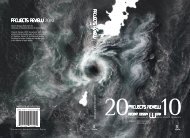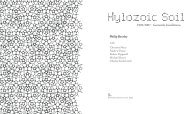The Inner Studio - Riverside Architectural Press
The Inner Studio - Riverside Architectural Press
The Inner Studio - Riverside Architectural Press
You also want an ePaper? Increase the reach of your titles
YUMPU automatically turns print PDFs into web optimized ePapers that Google loves.
THE INNER STUDIO<br />
A place that welcomes and supports stillness.<br />
A place that looks quiet.<br />
A place that suggests we move slowly.<br />
A place where our creative faculty is nurtured and refreshed.<br />
An outdoor place for inactivity.<br />
A place where worn-out people can relax.<br />
A room where the mind naturally slows down.<br />
A place where we are invited to feel heavy.<br />
A room that reminds us of the existence of our bodies.<br />
A garden that reminds us of the needs of our bodies.<br />
At the close of this exercise take a moment to review the images you<br />
have received. If any of them move you, make sure you follow your<br />
inspiration and record these impressions in some way. <strong>The</strong> greater the<br />
energy these images hold, the more you might want to creatively reflect<br />
on and integrate their content.<br />
Body-Centered Design<br />
We have collectively been treating the earth, air, rivers, and oceans<br />
the same way we treat our own bodies: as something inferior.<br />
Patriarchy has had a long history of believing in masculine superiority<br />
over the feminine. <strong>The</strong>re is no logical basis to this, just as<br />
there is no logical basis for harming the natural environment. No<br />
one thrives in a situation in which they are consistently treated as<br />
inferior. We don’t like it and the environment surely doesn’t. But<br />
without looking at these issues psychologically, it is difficult to<br />
understand a role for our feelings in design decisions.<br />
<strong>The</strong> first step toward body-centered design is to simply become<br />
aware of your whole body, experiencing the felt sense of the body.<br />
Rather than beginning with a focused desire to create or solve,<br />
begin with an attitude of readiness to receive an impression from<br />
your body. For some, this first step is the most difficult because, as<br />
a designer, you are asked not to design or anticipate the design;<br />
you are asked to do nothing. Don’t take a position toward the<br />
problem. Instead, go into your own felt experience of your body<br />
and make contact with it in the moment. We usually rush past this<br />
experience–I am suggesting that we linger with the feeling. For me,<br />
64





